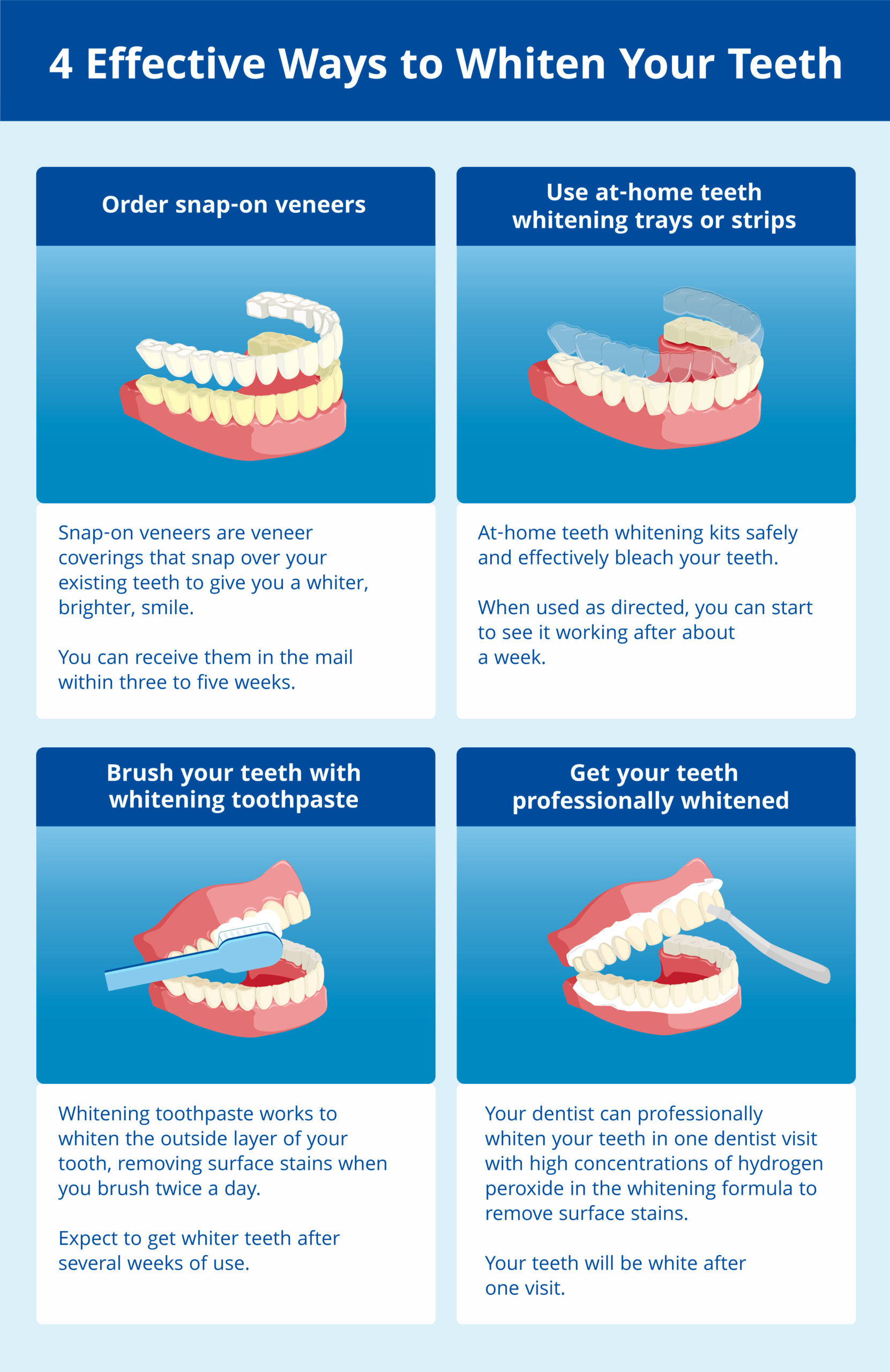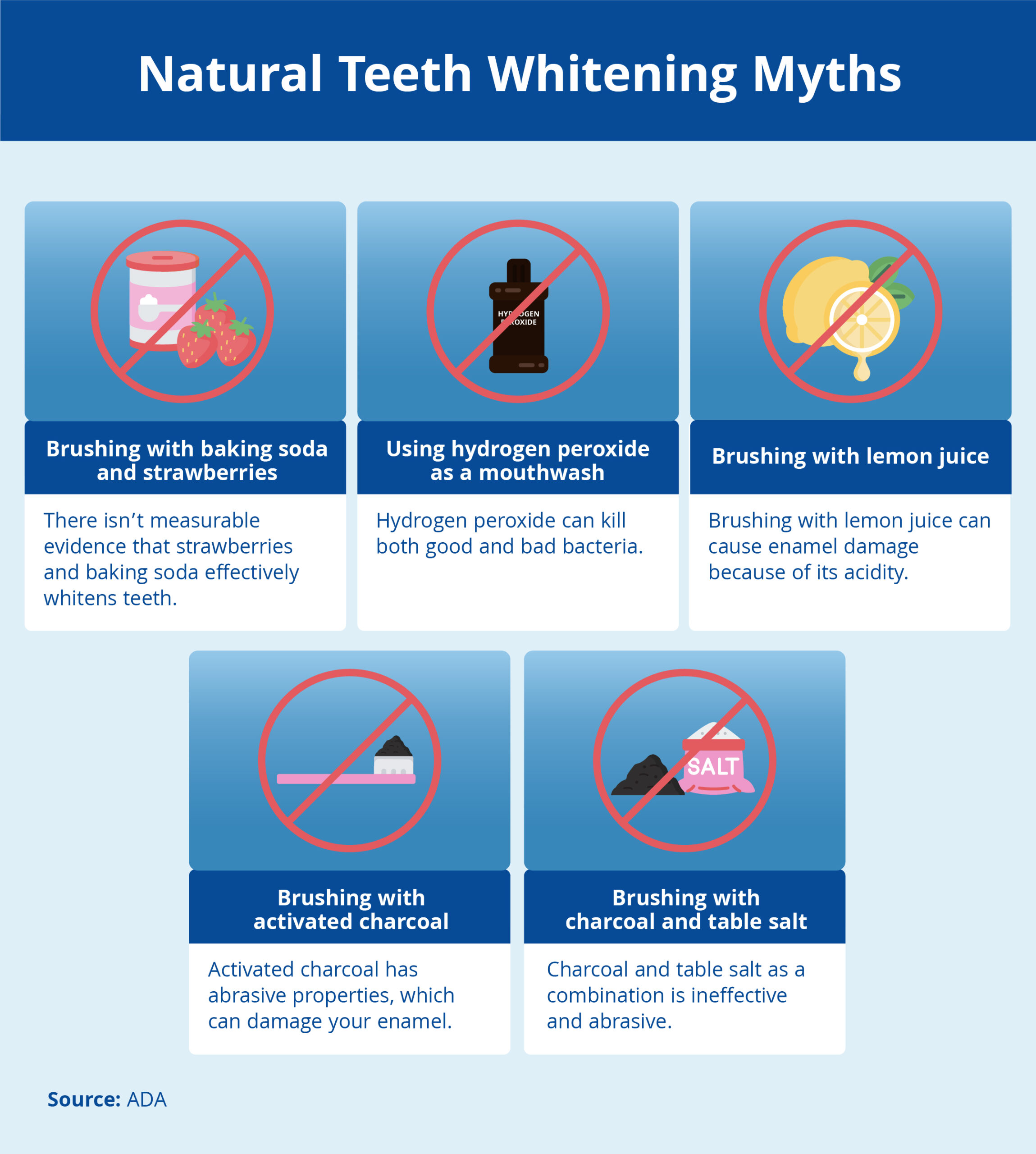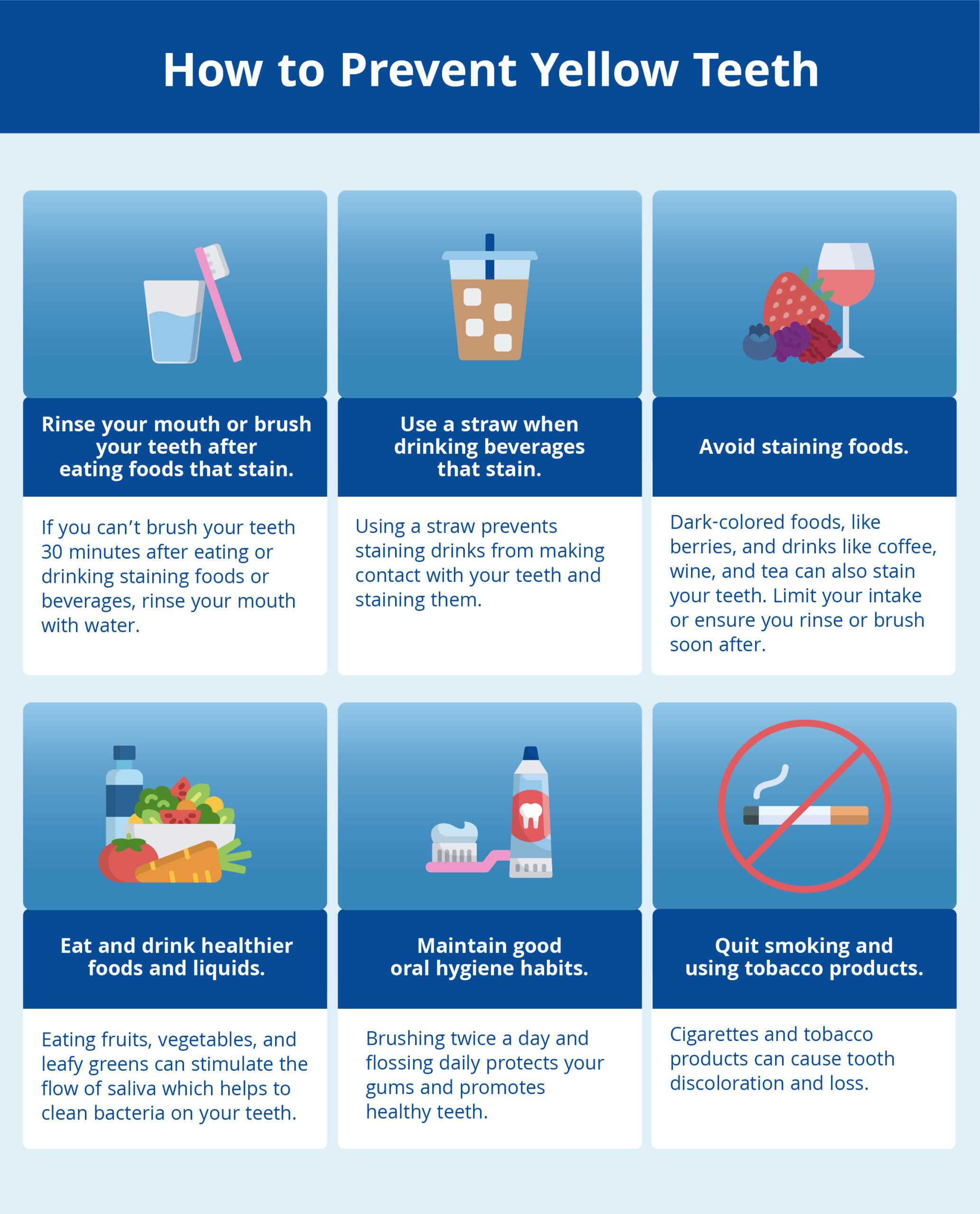

If you want to whiten yellow teeth or teeth with staining, there are many teeth whitening treatments you can use to get the bright, white smile you deserve.
Teeth can become stained or discolored by either intrinsic or extrinsic stains. Intrinsic stains are inside the tooth, impacting the color of the enamel or dentin, which at-home remedies can’t fix. Extrinsic stains, on the other hand, are caused by wine, coffee, tobacco products, or other external factors that stain the surface of your teeth. These types of stains can be addressed with at-home teeth whitening methods.
You may have seen so-called “natural” teeth whitening remedies from other sources, but it’s important to understand that most, if not all, are actually doing more harm to your teeth than good.
Something that can improve the appearance of your teeth instantly are snap-on veneers, a practical option that snaps over your existing teeth, helping you avoid costly and uncomfortable professional teeth whitening treatments.
This post helps you understand your options for getting rid of yellow teeth while also debunking the so-called “natural” remedies that may actually cause harm.
Effective Ways to Whiten Your Teeth
There are plenty of viral hacks to whiten teeth, but they’re not recommended by the American Dental Association. Some of them don’t help tooth discoloration at all and can cause you more harm than good. Here are some safe, effective, and proven methods for teeth-whitening.

Order snap-on veneers
You can order snap-on veneers through Shiny Smile Veneers for a new and improved smile without going through any dental pain or dentist appointments. The veneers cover your teeth and give you the appearance of a whiter, brighter, smile. They also address other aesthetic issues, like crooked or chipped teeth. These snap-on veneers cost $570 for upper and lower arches and should last you one to five years.
How it works:
- Snap-on veneers clip over your teeth so you have a perfect white smile.
- Order the impression kit, take the impressions, send the impression kit back, and within three to five weeks, you can have a new smile.
How soon will it whiten your teeth?
- As soon as you receive the snap-on veneers in the mail — in three to five weeks with normal shipping and two with expedited shipping.
Use at-home teeth whitening trays or strips
At-home teeth whitening strips or trays can be effective at removing extrinsic stains. Most of the products contain hydrogen peroxide which naturally bleaches the teeth. You don’t need to visit a dentist’s office to try this method. Many at-home whitening products are available over the counter.
How it works:
- The hydrogen peroxide breaks down the stain molecules, like those caused by coffee or wine, and bleaches it to white.
How soon will it whiten your teeth?
- You will see visible results after about a week of daily use.
Brush your teeth with whitening toothpaste
Whitening toothpaste does work to whiten your teeth if you have extrinsic stains. It targets yellowing or discoloration on the outside layer of the tooth. Whitening toothpaste works to remove surface stains that regular, non-whitening toothpaste can’t.
How to use it:
- Brush your teeth twice a day using whitening toothpaste.
How soon will it whiten your teeth?
- It can take several weeks before you notice a difference.
Get your teeth professionally whitened
Getting your teeth professionally whitened can be a painful and expensive process and is usually meant to whiten your teeth if they are intrinsically stained.
Because the process uses higher concentrations of hydrogen peroxide, your teeth may be more sensitive to the bleaching agent. It can also be an uncomfortable experience as your mouth will be propped open for the whitening sessions. It’s effective, however — the bleach and peroxide mix is powerful enough to remove both surface and deep stains.
A word of caution:
This can be a painful treatment option because you may have bleaching sensitivity which can lead to pain in the dentin or your teeth.
How it works:
- Your dentist will prop your mouth open with a rubber mouth opener.
- The dentist will put a gum barrier on your gums so they don’t get bleached.
- Your dentist will then apply the bleaching gel on your teeth and then put a laser onto your teeth that heats the gel to activate the whitening so it lightens your teeth.
- Once it’s done and your teeth are to the level you want, your dentist will remove the barrier and mouth opener.
How soon will it whiten your teeth?
- The day of the treatment.
Natural Teeth Whitening Myths
There are many “hacks” for whitening teeth, but these aren’t approved by the ADA for various reasons, from the potential to wear down enamel to general ineffectiveness.
While you may be looking for a cheaper, natural, or faster remedy to whiten your teeth, you should be aware that something labeled as natural isn’t always the best option. Sometimes, spending a bit more money or taking a bit more time to get whiter teeth is the best way to go and will actually give you the result you want.

Brushing with baking soda and strawberries
A study examined the results of brushing with a strawberry and baking soda mix and did not see measurable whitening improvement.
Similarly, this study tried to find if strawberries mashed up and applied to your toothbrush could whiten your teeth. The results? There wasn’t enough evidence or support to indicate that this was a feasible method.
While whitening products with baking soda can remove stains from your teeth and help whiten them, brushing with it alone isn’t recommended. Baking soda is a mild abrasive and can wear down enamel if overused. Enamel does not grow back, so once it’s gone, it’s gone for good.
Rather than mixing baking soda with strawberries, or one or the other, you’d get a much better result from using a whitening toothpaste with baking soda that has an ADA seal of approval.
Hydrogen peroxide as a mouthwash
While hydrogen peroxide in specially formulated whitening products does a good job of whitening intrinsic stains, rinsing with it or swishing it around in your mouth won’t significantly impact whitening since it isn’t in contact with your teeth long enough to make a difference.
Even whitening mouth rinses containing hydrogen peroxide showed little improvement without being used in conjunction with other whitening methods, according to one study. Overuse of hydrogen peroxide as a rinse can also kill off the good bacteria in your mouth.
If you want to go the more natural route with an ingredient like hydrogen peroxide, you can use over-the-counter hydrogen peroxide-based teeth whitening products that are ADA-approved.
Brushing with lemon juice
Studies have shown that lemon juice can whiten teeth over time. However, this method doesn’t come without risks. Acids like lemon juice can cause tooth erosion, which can permanently damage your enamel.
Although lemon juice resulted in a white-frost appearance when used in this study, the risk isn’t worth the possible reward.
Brushing with activated charcoal
Activated charcoal is created through a high-temperature heating process of wood, coconut shells, or bamboo. Studies don’t show that it helps whiten teeth — rather, they’ve actually found the opposite to be true.
Activated charcoal–containing toothpastes aren’t as effective at whitening as the more conventional alternatives. Activated charcoal is also abrasive, making it unsafe for your enamel.
Brushing with charcoal and table salt
Studies show that brushing with charcoal and table salt is an abrasive and ineffective method. Not only does it not help whiten, but it also can cause a yellow cast on teeth, making the teeth look even worse than before.
Both charcoal and table salt are abrasive, meaning they can damage teeth and remove enamel during brushing, doing more harm than good.
What Causes Yellow Teeth?
Yellow teeth can happen for a variety of reasons. The cause is linked to what kind of stain it is, if it’s intrinsic — inside the tooth, impacting your dentin — or extrinsic — on the outer surface of the tooth. Yellow stains are typically associated with food stains.
Here are some of the most common causes of yellow teeth:
Intrinsic causes
- Prolonged use of antiseptic mouthwash can disrupt the natural balance of your oral microbiome, leading to a discoloration of the teeth’s inner dentin layer.
- Dental treatments or trauma can damage the inner tooth structure, causing a gradual yellowing from the inside out.
- Certain medications, notably tetracycline antibiotics and some high blood pressure medications, are known to cause intrinsic staining.
- Aging causes your outer enamel layer to thin over time, revealing more of the yellowish dentin beneath.
Extrinsic causes
- Excessive fluoride, particularly during early childhood, can lead to a condition known as dental fluorosis, which shows up as yellow or brown discolorations on the tooth surface.
- Poor oral hygiene causes plaque buildup and allows staining agents to accumulate on the outer layer of teeth, which causes yellowing over time.
- Dark-colored foods or drinks, such as coffee, tea, or certain berries, can leave stains on the tooth enamel.
- Smoking or using tobacco releases harmful chemicals that cause stubborn stains on the tooth’s external surface.
How to Prevent Yellow Teeth
Now that you know the ways you can safely address yellow teeth, we’ll go over how to prevent your teeth from yellowing in the future.
Keep in mind that everyone’s tooth color is unique. Having “white” teeth may mean a variety of different shades. But having good oral hygiene goes a long way to helping your teeth not only look nice but be healthier, too.

To help prevent yellowing:
- Rinse your mouth or brush your teeth after eating foods that stain. For example, drink a glass of water after your cup of coffee to rinse your mouth and teeth to prevent bacteria from forming. Brush your teeth about 30 minutes after drinking coffee. Drinking or eating something acidic and then brushing too soon after can weaken your enamel, causing staining.
- Use a straw when drinking beverages that stain. When you drink teeth-staining drinks, like iced coffee, use a straw to avoid contact with your teeth.
- Avoid staining foods. Dark-colored foods like berries and drinks like coffee, red wine, and tea can stain your teeth. Limiting them or ensuring you rinse your mouth with water after will help you prevent extrinsic stains.
- Eat and drink healthier foods and liquids. As the old saying goes, you are what you eat. Your diet directly impacts how your teeth look as well as how healthy they are. Incorporating more fruits and vegetables, especially leafy greens and crunchy vegetables, can help stimulate the flow of saliva and leave your teeth much cleaner.
- Brush your teeth regularly and go for regular dental checkups. Proper oral care goes a long way in terms of prevention. Not practicing good oral hygiene habits like brushing and flossing can be detrimental to your teeth’s appearance as well as your overall oral health, and visiting your dentist regularly helps spot issues like gingivitis or gum disease early before they become an issue.
- Quit smoking: We all know smoking is bad for us, but if you’re finding it hard to quit, here’s one more reason to do so. If you smoke and are dealing with yellowing, the easiest way to improve your teeth is by quitting smoking. Here’s a resource on how to do that.
Regain Your Confident Smile!
It’s hard to feel like yourself if you aren’t confident in your smile. While many at-home and in-office treatments can help fight discoloration, Shiny Smile snap-on veneers can give you the bright, white smile you deserve in an instant.
They’re completely customizable, so you can choose what shade of white you want. We also offer a 15-month warranty on our snap-on veneers, and are happy to help adjust them if they aren’t everything you hoped for.
Our veneers won’t hurt your teeth or wear down your enamel. Just snap them on and start smiling with confidence.
